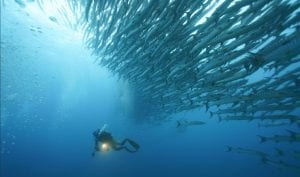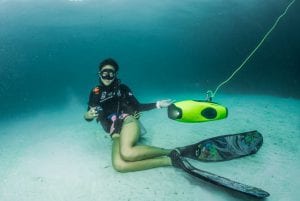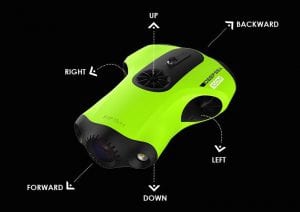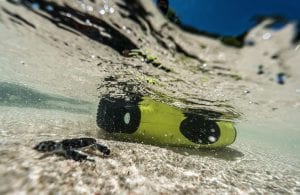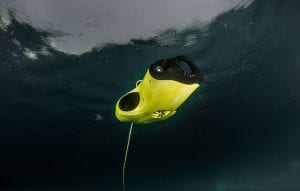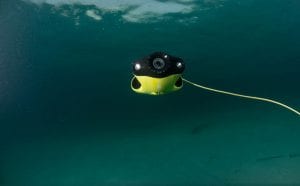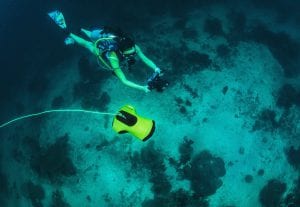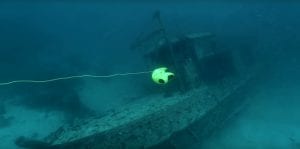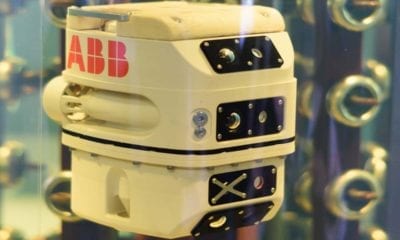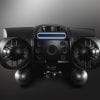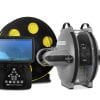AI
Into the Deep with FIFISH Underwater Drone – Interview with Belinda Zhang, Qysea Founder
Qysea, a manufacturer of underwater remotely operated vehicles, has developed the FIFISH P3 to be one of the most advanced underwater drones capable of high resolution video (4K HD) and photography recording, with enhanced contrast even at depths of up to 100m. Aimed at professional users, the remote-controlled P3 boasts of strong industrial design for reliability and performance. The FIFISH P3 was the winner of the CES 2018 Innovation Award in Las Vegas. We spoke to CEO and founder of Qysea about this exciting entry to the underwater drone / ROV market place.
Can you tell us some of the background behind the founders of QYSEA?
 Before I came to Qysea, I was originally in charge of R&D in FOXCONN with more than 11 years experience on the design, manufacture, quality control, supplier chain management and sales and oversea marketing. I led and participated in R&D, the manufacture and sales of more than 30 products including Apple, Nintendo Wii/NDS, Sony TV/PSP, SBB, Panasonic, Brother and other products of 500 leading companies.
Before I came to Qysea, I was originally in charge of R&D in FOXCONN with more than 11 years experience on the design, manufacture, quality control, supplier chain management and sales and oversea marketing. I led and participated in R&D, the manufacture and sales of more than 30 products including Apple, Nintendo Wii/NDS, Sony TV/PSP, SBB, Panasonic, Brother and other products of 500 leading companies.
My special interest however is in R&D, having been instrumental in 4 patents (3 US patents and 1 Chinese patent) and 2 patents for utility models. I am also a keen underwater sports enthusiastic and certified PADI open water diver.
What was the inspiration for the creation of the FIFISH?
As we all know, there are 12 men that have walked on the moon, 500 human beings have been to space and although the sea covers 70% of the earth, only 3 have dived into the murky darkness of Challenger Deep, the deepest point under the sea.
More and more people are eager to explore the vast ocean nowadays. Over the past few years, we are seeing a significant increase in numbers of divers each year. More and more people actually have the desire to explore what is down the surface. However, scuba diving or free diving needs special training and it can be dangerous sometimes. Right now, without diving apparatus, there are no easy tools for ocean exploration. As a scuba diver myself, I enjoy capturing and recording every moment under the water. I would like to make this more accessible to many people, especially even for those who are scared of water, so they could also capture epic underwater moments.
What’s more, we have seen a huge boost in robotics and artificial intelligence in recent years. The success of DJI is a great proof that we can successfully bring robotics and artificial intelligence into our ordinary life and bring consumers a whole new perspective of seeing the world. And for underwater drones, there is even greater meaning. Most of our team members are scuba divers and we know that underwater world is a very different world, we also know that the ocean is suffering from pollution; coral is disappearing; marine lives are being threatened by environmental change. We feel the urge to help people understand more about the ocean, and then to have the desire to protect it.
Our dream is to offer a quality option by applying AI/robotic technology into our product and to open a new perspective for underwater researchers and consumers. And even more, we hope to bring a huge boost to the development of marine technology, and arouse people’s concern for positive change for the ocean world!
In addition to today’s economic environment worldwide, consumption upgrade is a phrase we often use right now. It means that consumers not only pursue products with functions that suit their needs, but also, they place higher standards upon their self-expression and also emotional needs. Our products can also represent our way of pursuing life.
The last but not the least is that up till now, we see a transformation of industries. The traditional ocean industry has certain barriers, it is more limited to military and industrial applications. How to adjust the industrial structure, and make the related technology and applications suits more ordinary applications is a task ocean-related companies are striving for in recent years.
With all the motivations of above reasons, we see a huge opportunity and potential for growth in our product. That is why FIFISH was created!
Congratulations on your second year running CES innovation award. How has the FIFISH P3 been received?
It is a great honor for us to win two CES innovation awards in succession. Since we all know that the CES innovation awards are an annual competition honoring outstanding design and engineering in consumer technology products, it is a recognition for our effort and product. We humbly appreciate that.
We’ve spent two years in product development stage and we’ve made huge breakthroughs in the underwater industry by addressing technical development barriers for our products, from aesthetic design, to engineering quality as well as function.
The ID design is colorful and fashionable, and the body is streamlined, unique and efficient. After comprehensive and repeated hydrodynamic simulation and experiments, the machine moves very stable at current interference.
The reliability of the products also stands out. Multiple pressure and anti-corrison tests have been done to ensure long term guarantee to end users. The best in the current market.
The camera has an obvious advantage comparing with other underwater drone in current market. We specially designed an underwater lens with an ultra wide angle of 162 FOV, which can take 4K high definition video and 20 Mega Pixel photos. This combined with abundant lighting of 4,000 lumens, ensures truly great underwater shots. The stabilized camera with shooting algorithm is a great guarantee for stable footage. Multiple shooting modes from micro to normal modes can ensure the camera fits all sorts of scenes.
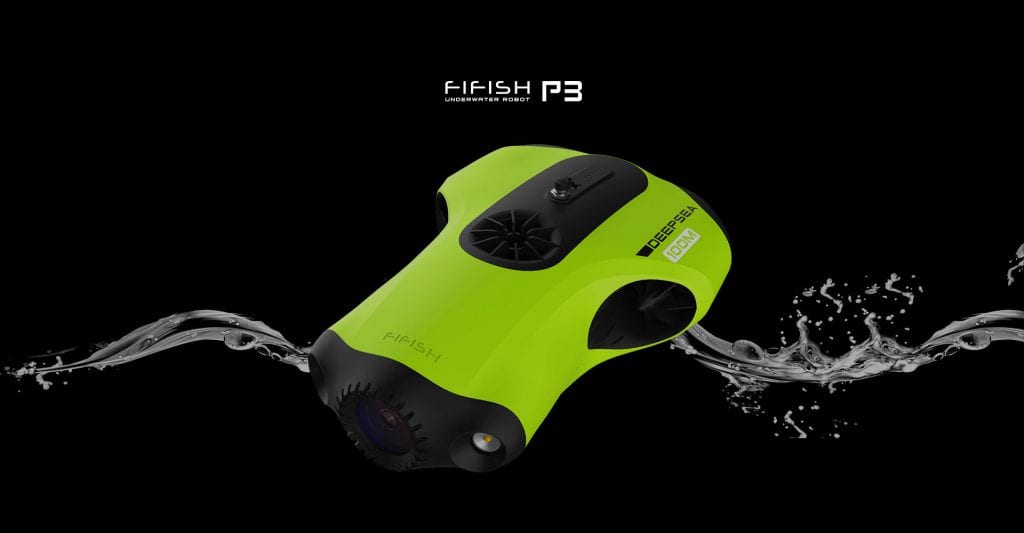
You recently ran a wildly successful crowdfunding campaign to help get FIFISH into the water, so to speak, raising almost 600% of your funding target. Where are you now in the development stage?
We are at a rapid development stage. Right now, we are expanding all sorts of applications for our products and explore all sorts of possibilities. We are continuing to develop the technology and in the middle of developing a wireless underwater drone at the moment.
FIFISH P3 is in the process of mass production and we can ship our product at the end of May, which is targeted at the consumer market at a price of only $3500. We also have light industrial versions for applications like rescue searching, inspection, fishery and so on.
We also have established a long-term partnership with distributors in USA, Japan and European. More and more consumers will seen FIFISH P3 on the market soon.
FIFISH P3 can dive to a depth of 100m – quite impressive. Were there any challenges in the design process creating a body to withstand those pressures, and any difference between the salt and freshwater environments?
Yes, we have encountered lots of tough problems during the design process. There are many design obstacles to overcome even to withstand water pressure 50 meters down the water. In order to conquer these issues we changed designs and materials, in fact we even didn’t use glue for the water-proof design which is a great challenge for underwater drone. Lots of pressure tests have been done to ensure the reliability. With all the effort we have done, water-proof sealed and cylindrical tank with 3.5mm thickness make FIFISH P3 dive to depths of 100m, our vision has come to life.
Actually, there is no big difference for FIFISH P3 to perform in salt or freshwater environment since we have apply special surface treatment on the tank.
How about collision avoidance / detection?
Collision underwater is unavoidable in a degree. However, we have taken measures to protect our product. We have designed FIFISH APP to see real-time images and especially there is one plastic case in front of FIFISH P3 to protect the camera.
How long can the FIFISH P3 remain active for underwater? Are there charging / battery change procedures for quick turnaround?
FIFISH is equipped with lithium battery. With charging 3.5 hours, FIFISH P3 can operate in the ocean for 2 hours constantly.
Are there any redundancy / safety options in cases of say, damage to the umbilical or casing?
We have done continuous thermal shock tests for 120 hours, high and low temperature storage tests for 1000 hours, firmware sub-bit upgrade pressure tests 1000 times, 100m depth stress test for 200 cycles and zero buoyancy force cable wire breakage verification at 80 kgf.
We have made the most effort to ensure FIFISH P3 can be used at best status. If umbilical or casing still damaged, then it needs to be changed.
Any plans to go deeper than 100m in future models?
Yes, we do have those plans. We hope to provide people tools to explore a much deeper world.
Please tell us about the camera, sensor and lighting the FIFISHP3 carries? What advantages does it have over competitors?
The best advantage of FIFISH P3 is its professional camera. We have 4K cameras with a 1 inch SONY sensor, a specially designed underwater lens, and ambarella chipset. It can take 4K video and 20MP photos of very high quality. To create enough light for deep water photography, we have 2*2000 lumens very bright LEDS in the front. Red light is absorbed by water at certain depth, which is why all things in the ocean look blue or green. We have LED with bright light to ensure the color rendition for underwater photography. With all the time we have spent a lot on the camera system, we believe it is much better than other similar products.
What’s more, to ensure waterproofing, our current solution is to not use glue, the integrity of which can be affected by water. By thoroughly testing and veriying, we have been able to ensure the reliability of water proofing at all sorts of temperatures and conditions.
Are there any other kind of data collection sensors? What are the image data processing capacities of the FIFISH P3?
The machine is integrated with high precision depth sensors and tilt sensors, and with a single click of a button, the machine can hover at any depth and location with high precision and great stability. Also, it has a few interfaces where people can easily attach multiple sensors to expand the machine’s function.
What are the capabilities of the proprietary software?
There is an user-friendly App called FIFISH app which can allow you to see the real-time underwater images including real-time depth, movements, battery life etc.
The APP has a wide range of of functions. All footage taken can be marked with exact depth at the time it was taken. Once one finishes the shots, footage can be edited via the FIFISH App and shared instantly through social media, or even streamline live broadcast during the diving trip to Facebook, Youtube etc. It also has a community feature in the app where you can share your great shots with other ocean enthusiasts all sorts of explorations.
Using from FIFISH APP, auto-depth, and auto-navigation also can be defined when using the FIFISH P3.
Do you plan to have the FIFISH able to carry any custom payloads?
Yes, we have plans for future generation product especially for light-industry products to carry payloads.
What do you see as the possible consumer and commercial applications of the FIFISH P3 ?
For the consumer application, we mostly envison FIFISH being used for diving, underwater photography, underwater videography and underwater exploration etc. For free diving areas, we’ve been in contact with free diving international associations, like Andi etc. We understand that the free diving is very dangerous as divers are diving into depth below 100 meters without any equipment, which present safety issues for the divers with limited sea surface observation capabilities. We are working on applying our product to follow free divers during their diving and let people on shore understands what’s happening and if any safety precautions need to be taken.
For commercial applications, FIFISH is used for rescue, research, inspection etc. We’ve been exploring all sorts of other applications with our product. We’ve helped Blue Sky Rescue team upon some of their rescue projects. We also have cooperated the largest water project “south-north water project” in China for water inspection.
We are also willing to use our product to participate in public welfare activities, to help shoulder social responsibilities.
What does the future hold for Qysea?
We are hoping to provide more and more easy use and meaningful tools for people to explore the ocean, to make good use of the resources and most importantly, to protect it.
For consumer-grade product, we wish to provide smaller, cheaper products even wireless products for more and more people could afford and explore the underwater world in a much easier way.
For light-industry product, FIFISH will continue to make breakthrough over technical barriers even offer customized product for multifunctional use. We do hope to help proceed the development of marine technology.
We will continue to update our brand and product information on our website to let people know more about us.
Where do you see the underwater drone market heading in the next five years?
The underwater drone market has huge potential. We are seeing a increase in underwater drone companies all over the world in recent years. A lot of efforts and resources have been invested into this industry, so in the next five years, we are hoping to see a huge boost in the ocean industry, and to see robotics and AI application be developed to change the ways people explore the ocean.
We welcome readers to visit our website at or follow us on Facebook.


